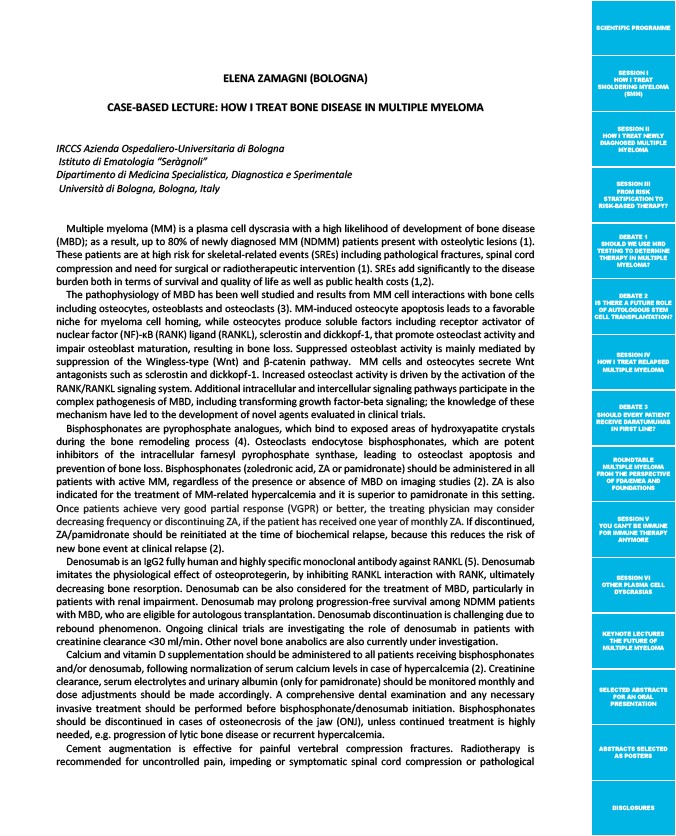
SCIENTIFIC PROGRAMME
SESSION I
HOW I TREAT
SMOLDERING MYELOMA
(SMM)
SESSION II
HOW I TREAT NEWLY
DIAGNOSED MULTIPLE
MYELOMA
SESSION III
FROM RISK
STRATIFICATION TO
RISK-BASED THERAPY?
DEBATE 1
SHOULD WE USE MRD
TESTING TO DETERMINE
THERAPY IN MULTIPLE
MYELOMA?
DEBATE 2
IS THERE A FUTURE ROLE
OF AUTOLOGOUS STEM
CELL TRANSPLANTATION?
SESSION IV
HOW I TREAT RELAPSED
MULTIPLE MYELOMA
DEBATE 3
SHOULD EVERY PATIENT
RECEIVE DARATUMUMAB
IN FIRST LINE?
ROUNDTABLE
MULTIPLE MYELOMA
FROM THE PERSPECTIVE
OF FDA/EMEA AND
FOUNDATIONS
SESSION V
YOU CAN’T BE IMMUNE
FOR IMMUNE THERAPY
ANYMORE
SESSION VI
OTHER PLASMA CELL
DYSCRASIAS
KEYNOTE LECTURES
THE FUTURE OF
MULTIPLE MYELOMA
SELECTED ABSTRACTS
FOR AN ORAL
PRESENTATION
ABSTRACTS SELECTED
AS POSTERS
DISCLOSURES
ELENA ZAMAGNI (BOLOGNA)
CASE-BASED LECTURE: HOW I TREAT BONE DISEASE IN MULTIPLE MYELOMA
IRCCS Azienda Ospedaliero-Universitaria di Bologna
Istituto di Ematologia “Seràgnoli”
Dipartimento di Medicina Specialistica, Diagnostica e Sperimentale
Università di Bologna, Bologna, Italy
Multiple myeloma (MM) is a plasma cell dyscrasia with a high likelihood of development of bone disease
(MBD); as a result, up to 80% of newly diagnosed MM (NDMM) patients present with osteolytic lesions (1).
These patients are at high risk for skeletal-related events (SREs) including pathological fractures, spinal cord
compression and need for surgical or radiotherapeutic intervention (1). SREs add significantly to the disease
burden both in terms of survival and quality of life as well as public health costs (1,2).
The pathophysiology of MBD has been well studied and results from MM cell interactions with bone cells
including osteocytes, osteoblasts and osteoclasts (3). MM-induced osteocyte apoptosis leads to a favorable
niche for myeloma cell homing, while osteocytes produce soluble factors including receptor activator of
nuclear factor (NF)-κB (RANK) ligand (RANKL), sclerostin and dickkopf-1, that promote osteoclast activity and
impair osteoblast maturation, resulting in bone loss. Suppressed osteoblast activity is mainly mediated by
suppression of the Wingless-type (Wnt) and β-catenin pathway. MM cells and osteocytes secrete Wnt
antagonists such as sclerostin and dickkopf-1. Increased osteoclast activity is driven by the activation of the
RANK/RANKL signaling system. Additional intracellular and intercellular signaling pathways participate in the
complex pathogenesis of MBD, including transforming growth factor-beta signaling; the knowledge of these
mechanism have led to the development of novel agents evaluated in clinical trials.
Bisphosphonates are pyrophosphate analogues, which bind to exposed areas of hydroxyapatite crystals
during the bone remodeling process (4). Osteoclasts endocytose bisphosphonates, which are potent
inhibitors of the intracellular farnesyl pyrophosphate synthase, leading to osteoclast apoptosis and
prevention of bone loss. Bisphosphonates (zoledronic acid, ZA or pamidronate) should be administered in all
patients with active MM, regardless of the presence or absence of MBD on imaging studies (2). ZA is also
indicated for the treatment of MM-related hypercalcemia and it is superior to pamidronate in this setting.
Once patients achieve very good partial response (VGPR) or better, the treating physician may consider
decreasing frequency or discontinuing ZA, if the patient has received one year of monthly ZA. If discontinued,
ZA/pamidronate should be reinitiated at the time of biochemical relapse, because this reduces the risk of
new bone event at clinical relapse (2).
Denosumab is an IgG2 fully human and highly specific monoclonal antibody against RANKL (5). Denosumab
imitates the physiological effect of osteoprotegerin, by inhibiting RANKL interaction with RANK, ultimately
decreasing bone resorption. Denosumab can be also considered for the treatment of MBD, particularly in
patients with renal impairment. Denosumab may prolong progression-free survival among NDMM patients
with MBD, who are eligible for autologous transplantation. Denosumab discontinuation is challenging due to
rebound phenomenon. Ongoing clinical trials are investigating the role of denosumab in patients with
creatinine clearance <30 ml/min. Other novel bone anabolics are also currently under investigation.
Calcium and vitamin D supplementation should be administered to all patients receiving bisphosphonates
and/or denosumab, following normalization of serum calcium levels in case of hypercalcemia (2). Creatinine
clearance, serum electrolytes and urinary albumin (only for pamidronate) should be monitored monthly and
dose adjustments should be made accordingly. A comprehensive dental examination and any necessary
invasive treatment should be performed before bisphosphonate/denosumab initiation. Bisphosphonates
should be discontinued in cases of osteonecrosis of the jaw (ONJ), unless continued treatment is highly
needed, e.g. progression of lytic bone disease or recurrent hypercalcemia.
Cement augmentation is effective for painful vertebral compression fractures. Radiotherapy is
recommended for uncontrolled pain, impeding or symptomatic spinal cord compression or pathological